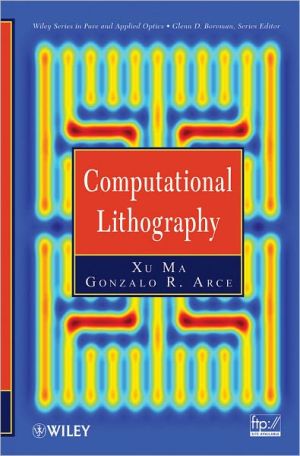

 |

|

Sold Out
Book Categories |
Preface xi
Acknowledgments xiii
Acronyms xv
1 Introduction 1
1.1 Optical Lithography 1
1.1.1 Optical Lithography and Integrated Circuits 2
1.1.2 Brief History of Optical Lithography Systems 3
1.2 Rayleigh's Resolution 5
1.3 Resist Processes and Characteristics 7
1.4 Techniques in Computational Lithography 10
1.4.1 Optical Proximity Correction 11
1.4.2 Phase-Shifting Masks 11
1.4.3 Off-Axis Illumination 14
1.4.4 Second-Generation RETs 15
1.5 Outline 16
2 Optical Lithography Systems 19
2.1 Partially Coherent Imaging Systems 19
2.1.1 Abbe's Model 19
2.1.2 Hopkins Diffraction Model 22
2.1.3 Coherent and Incoherent Imaging Systems 24
2.2 Approximation Models 25
2.2.1 Fourier Series Expansion Model 25
2.2.2 Singular Value Decomposition Model 29
2.2.3 Average Coherent Approximation Model 32
2.2.4 Discussion and Comparison 34
2.3 Summary 36
3 Rule-Based Resolution Enhancement Techniques 37
3.1 RET Types 37
3.1.1 Rule-Based RETs 37
3.1.2 Model-Based RETs 38
3.1.3 Hybrid RETs 39
3.2 Rule-Based OPC 39
3.2.1 Catastrophic OPC 40
3.2.2 One-Dimensional OPC 40
3.2.3 Line-Shortening Reduction OPC 42
3.2.4 Two-Dimensional OPC 43
3.3 Rule-Based PSM 44
3.3.1 Dark-Field Application 44
3.3.2 Light-Field Application 45
3.4 Rule-Based OAI 46
3.5 Summary 47
4 Fundamentals of Optimization 48
4.1 Definition and Classification 48
4.1.1 Definitions in the Optimization Problem 48
4.1.2 Classification of Optimization Problems 49
4.2 Unconstrained Optimization 50
4.2.1 Solution of Unconstrained Optimization Problem 50
4.2.2 Unconstrained Optimization Algorithms 52
4.3 Summary 57
5 Computational Lithography with Coherent Illumination 58
5.1 Problem Formulation 59
5.2 OPC Optimization 62
5.2.1 OPC Design Algorithm 62
5.2.2 Simulations 64
5.3 Two-Phase PSM Optimization 65
5.3.1 Two-Phase PSM Design Algorithm 65
5.3.2 Simulations 68
5.4 Generalized PSM Optimization 72
5.4.1 Generalized PSM Design Algorithm 72
5.4.2 Simulations 75
5.5 Resist Modeling Effects 79
5.6 Summary 82
6 Regularization Framework 83
6.1 Discretization Penalty 84
6.1.1 Discretization Penalty for OPC Optimization 84
6.1.2 Discretization Penalty for Two-Phase PSM Optimization 86
6.1.3 Discretization Penalty for Generalized PSM Optimization 87
6.2 Complexity Penalty 93
6.2.1 Total Variation Penalty 93
6.2.2 Global Wavelet Penalty 94
6.2.3 Localized Wavelet Penalty 98
6.3 Summary 100
7 Computational Lithography with Partially Coherent Illumination 101
7.1 OPC Optimization 102
7.1.1 OPC Design Algorithm Using the Fourier Series Expansion Model 102
7.1.2 Simulations Using the Fourier Series Expansion Model 105
7.1.3 OPC Design Algorithm Using the Average Coherent Approximation Model 107
7.1.4 Simulations Using the Average Coherent Approximation Model 111
7.1.5 Discussion and Comparison 111
7.2 PSM Optimization 115
7.2.1 PSM Design Algorithm Using the Singular Value Decomposition Model 116
7.2.2 Discretization Regularization for PSM Design Algorithm 118
7.2.3 Simulations 118
7.3 Summary 122
8 Other RET Optimization Techniques 123
8.1 Double-Patterning Method 123
8.2 Post-Processing Based on 2D DCT 128
8.3 Photoresist Tone Reversing Method 131
8.4 Summary 135
9 Source and Mask Optimization 136
9.1 Lithography Preliminaries 137
9.2 Topological Constraint 140
9.3 Source-Mask Optimization Algorithm 141
9.4 Simulations 141
9.5 Summary 145
10 Coherent Thick-Mask Optimization 146
10.1 Kirchhoff Boundary Conditions 147
10.2 Boundary Layer Model 147
10.2.1 Boundary Layer Model in Coherent Imaging Systems 147
10.2.2 Boundary Layer Model in Partially Coherent Imaging Systems 151
10.3 Lithography Preliminaries 153
10.4 OPC Optimization 157
10.4.1 Topological Constraint 157
10.4.2 OPC Optimization Algorithm Based on BL Model Under Coherent Illumination 158
10.4.3 Simulations 159
10.5 PSM Optimization 162
10.5.1 Topological Constraint 162
10.5.2 PSM Optimization Algorithm Based on BL Model Under Coherent Illumination 165
10.5.3 Simulations 165
10.6 Summary 170
11 Conclusions and New Directions of Computational Lithography 171
11.1 Conclusion 171
11.2 New Directions of Computational Lithography 173
11.2.1 OPC Optimization for the Next-Generation Lithography Technologies 173
11.2.2 Initialization Approach for the Inverse Lithography Optimization 173
11.2.3 Double Patterning and Double Exposure Methods in Partially Coherent Imaging System 174
11.2.4 OPC and PSM Optimizations for Inverse Lithography Based on Rigorous Mask Models in Partially Coherent Imaging System 174
11.2.5 Simultaneous Source and Mask Optimization for Inverse Lithography Based on Rigorous Mask Models 174
11.2.6 Investigation of Factors Influencing the Complexity of the OPC and PSM Optimization Algorithms 174
Appendix A Formula Derivation in Chapter 5 175
Appendix B Manhattan Geometry 181
Appendix C Formula Derivation in Chapter 6 182
Appendix D Formula Derivation in Chapter 7 185
Appendix E Formula Derivation in Chapter 8 189
Appendix F Formula Derivation in Chapter 9 194
Appendix G Formula Derivation in Chapter 10 195
Appendix H Software Guide 199
References 217
Index 223
Login|Complaints|Blog|Games|Digital Media|Souls|Obituary|Contact Us|FAQ
CAN'T FIND WHAT YOU'RE LOOKING FOR? CLICK HERE!!! X
 You must be logged in to add to WishlistX
 This item is in your Wish ListX
 This item is in your CollectionComputational Lithography
X
 This Item is in Your InventoryComputational Lithography
X
 You must be logged in to review the productsX
 X
 X

Add Computational Lithography, A Unified Summary of the Models and Optimization Methods Used in Computational Lithography Optical lithography is one of the most challenging areas of current integrated circuit manufacturing technology. The semiconductor industry is relying mor, Computational Lithography to the inventory that you are selling on WonderClubX
 X

Add Computational Lithography, A Unified Summary of the Models and Optimization Methods Used in Computational Lithography Optical lithography is one of the most challenging areas of current integrated circuit manufacturing technology. The semiconductor industry is relying mor, Computational Lithography to your collection on WonderClub |